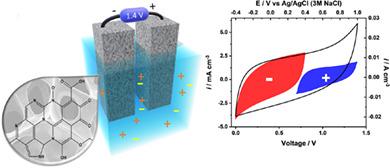当前位置:
X-MOL 学术
›
Int. J. Energy Res.
›
论文详情
Our official English website, www.x-mol.net, welcomes your feedback! (Note: you will need to create a separate account there.)
Incorporation of heteroatoms into reticulated vitreous carbon foams derived from sucrose to improve its energy storage performance
International Journal of Energy Research ( IF 4.6 ) Pub Date : 2020-11-12 , DOI: 10.1002/er.6193 Juvencio Vazquez‐Samperio 1, 2, 3 , Próspero Acevedo‐Peña 4 , Ariel Guzmán‐Vargas 2 , Edilso Reguera 1 , Elcy Cordoba‐Tuta 3
International Journal of Energy Research ( IF 4.6 ) Pub Date : 2020-11-12 , DOI: 10.1002/er.6193 Juvencio Vazquez‐Samperio 1, 2, 3 , Próspero Acevedo‐Peña 4 , Ariel Guzmán‐Vargas 2 , Edilso Reguera 1 , Elcy Cordoba‐Tuta 3
Affiliation

|
Herein, a binder‐free 3D reticulated carbon doped with N, F, and B is proposed as an excellent choice to be used as an electrode in volumetric supercapacitors for stationary devices. The carbonaceous electrode was obtained by pyrolysis (N2 atmosphere) of sucrose resin modified with precursors of heteroatoms doping, impregnated on the polyurethane foam used as a template. Different techniques such as SEM, Raman, XPS, and FTIR were employed to characterize the properties of RVC. Cyclic Voltammetry, Galvanostatic charge and discharge curves, and EIS were used to evaluate the energy storage performance of the foams. The electrochemical evaluation in acidic medium shows that the composition and chemical state of doping elements in the RVC determine their capacitance. RVC‐N electrode exhibits the best performance among the foams here synthetized registering volumetric capacitances of 3.57, 3.20, 2.25, 1.45, and 0.63 F cm−3 at 5, 10, 20, 40, and 80 mV s−1, respectively. Further, a symmetric supercapacitor was assembled by using RVC‐N as a positive and negative electrode. The device shows volumetric capacitances of 3.82, 1.4, 0.57, 0.47, 0.37, 0.24, and 0.15 F cm−3 at 0.5, 1, 2, 4, 6, 18 y 35 mA cm−3 inside a voltage window of 1.4 V. Moreover, the device retained the 80% of its initial capacitance after 10 000 cycles.
中文翻译:

将杂原子掺入源自蔗糖的网状玻璃碳泡沫中,以改善其储能性能
在本文中,提出了掺杂有N,F和B的无粘结剂3D网状碳作为在固定设备的体积超级电容器中用作电极的绝佳选择。通过热解(N 2气氛的蔗糖树脂用杂原子掺杂的前体改性,并浸渍在用作模板的聚氨酯泡沫中。使用诸如SEM,拉曼,XPS和FTIR的不同技术来表征RVC的特性。循环伏安法,恒电流充放电曲线和EIS用于评估泡沫的储能性能。在酸性介质中的电化学评估表明,RVC中掺杂元素的组成和化学状态决定了它们的电容。RVC‐N电极在泡沫中表现出最好的性能,在5、10、20、40和80 mV s -1时合成的记录体积电容分别为3.57、3.20、2.25、1.45和0.63 F cm -3, 分别。此外,通过使用RVC-N作为正负电极组装对称超级电容器。该器件在1.4 V电压窗口内在0.5、1、2、4、6、18 y 35 mA cm -3时显示3.82、1.4、0.57、0.47、0.37、0.24和0.15 F cm -3的体积电容。此外,该器件在10000次循环后仍保留了其初始电容的80%。
更新日期:2020-11-12
中文翻译:

将杂原子掺入源自蔗糖的网状玻璃碳泡沫中,以改善其储能性能
在本文中,提出了掺杂有N,F和B的无粘结剂3D网状碳作为在固定设备的体积超级电容器中用作电极的绝佳选择。通过热解(N 2气氛的蔗糖树脂用杂原子掺杂的前体改性,并浸渍在用作模板的聚氨酯泡沫中。使用诸如SEM,拉曼,XPS和FTIR的不同技术来表征RVC的特性。循环伏安法,恒电流充放电曲线和EIS用于评估泡沫的储能性能。在酸性介质中的电化学评估表明,RVC中掺杂元素的组成和化学状态决定了它们的电容。RVC‐N电极在泡沫中表现出最好的性能,在5、10、20、40和80 mV s -1时合成的记录体积电容分别为3.57、3.20、2.25、1.45和0.63 F cm -3, 分别。此外,通过使用RVC-N作为正负电极组装对称超级电容器。该器件在1.4 V电压窗口内在0.5、1、2、4、6、18 y 35 mA cm -3时显示3.82、1.4、0.57、0.47、0.37、0.24和0.15 F cm -3的体积电容。此外,该器件在10000次循环后仍保留了其初始电容的80%。


























 京公网安备 11010802027423号
京公网安备 11010802027423号